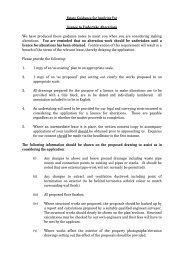Chelsea Insider Low - Cadogan
Chelsea Insider Low - Cadogan
Chelsea Insider Low - Cadogan
- No tags were found...
Create successful ePaper yourself
Turn your PDF publications into a flip-book with our unique Google optimized e-Paper software.
6 | HISTORY | A short history of <strong>Chelsea</strong>Royal Borough of Kensingon & <strong>Chelsea</strong>, Family & Children’s Servicethe lives of the residents in that period.The first mention of <strong>Chelsea</strong> – ‘cealchythe’– appears in the Anglo-SaxonChronicle’s AD 785 record as the placewhere a ‘litigious synod was holden’. TheOld English word ‘cealc’ can meanchalk, stone or lime, and ‘hythe’ translatesas ‘landing place’. It is possible that<strong>Chelsea</strong> was a stopping point for boatsshipping building materials or lime forfertiliser.Whatever its original purpose, <strong>Chelsea</strong>became a place of religious and politicalsignificance. Between AD 785 andAD 816, at least ten religious synodswere held in the area. It is thought thatthe Mercian kings, who largely ruled whatis now the Midlands, kept a residenceat <strong>Chelsea</strong> to in order to deal with theChurch and London. The etymology ofthe nearby hamlet of Kensal – derivedfrom cyning holt meaning ‘king’s wood’– also suggests there was a strongroyal link.The political importance of <strong>Chelsea</strong>was still in evidence at the end of theThe synod of AD785 as playedout at the <strong>Chelsea</strong> Pageantin 1908ninth century. Viking attacks had plaguedLondon and the surrounding area fromAD 830 onwards. According to theAnglo-Saxon Chronicle, there was “greatslaughter” in London in AD 839 – 850Viking ships entered the mouth of theThames in AD 851 and stormed Londonand Canterbury, and in AD 871 a “largeheathen army”, which had been inEngland since AD 866, captured Londonand wintered there.By AD 898, King Alfred the Great hadsuppressed the threat from Denmark witha series of victories, concluding the‘Danish War’. He then met with religiousand political leaders at <strong>Chelsea</strong> to discussthe refounding of London.Norman conquestIn AD 1086, 20 years after the Normanconquest which brought Anglo-Saxondominance in England to an end, theDomesday Book recorded that theManor of <strong>Chelsea</strong> – covering 780 acres ofmeadow, pastureland and woodland, andwith 60 pigs – was valued at nine pounds.In the centuries after the Normanconquest, <strong>Chelsea</strong> remained largelyunchanged. The Anglo-Saxon settlementby the river continued to be the focus ofthe area, and was surrounded by fields ofarable land. The Thames retained itsimportance to the village. Travelling byriver was faster and safer than by land,and <strong>Chelsea</strong>’s position on its banks, twoand a half miles upriver from Westminster,meant that a boat owner could travelthere quickly. This convenience became adraw for the rich and powerful, and fromthe 13th century onwards, court officials,nobles and kings are said to have usedthe area.The Black DeathEven though the Manor of <strong>Chelsea</strong>was quite secluded during this period,its proximity to London meant that it wasvulnerable to the plague. In the mid-14thHenry VIII andSir Thomas MoreBy the time Pepys was setting off on hisunfortunate journey, <strong>Chelsea</strong> had alreadyundergone major transformation.In the 16th century, great mansions beganto appear and a significant royal endorsementboosted the appeal of the village and itssurrounding area.Henry VIII apparently wanted to have a nurseryfor his children at <strong>Chelsea</strong> and was said to havewanted to live there following visits to the houseof his friend and advisor, Thomas More. WhenMore was executed in 1535, the king receivedMore’s house. He neglected it – his only recordedvisit was in 1538, when he stayed for two days.Henry had built his own manor house on thesite of today’s Cheyne Walk in 1536, wherePrincess Elizabeth, Lady Jane Grey and Anne ofCleves lived at various times. Sir Hans Sloanebought the Manor of <strong>Chelsea</strong> in 1712 (see SirHans Sloane).The royal connection meant that Crown propertiesin <strong>Chelsea</strong> could be used as residences formembers of the royal family and other notables.Henry granted a French Ambassador residenceat the house of the late Sir Thomas More for thesummer of 1538 so that he could take refugefrom the plague, and Thomas Cromwell, theking’s closest minister, was in <strong>Chelsea</strong> at thesame time.While the wealthy continued to be drawnto <strong>Chelsea</strong>, more humble settlers came too.By the mid-17th century, housing demand waspredominantly for smaller dwellings, rather thanimpressive mansions.The statue of Sir Thomas Moreoutside <strong>Chelsea</strong> Old Churchcentury, the Black Death ravaged London,and the manor of <strong>Chelsea</strong> along with it.Richard de Heyle, who inhabited themanor house at this time, saw his threechildren taken by the plague and, destitute,was forced to lease his property toWestminster Abbey for the duration ofhis life.Later, in 1630, the plague was stilla threat to the area, as can be seen ina draft proclamation warning residentsnot to entertain strangers and risk thespread of the pestilence. On April 9,1666, Samuel Pepys, “thinking to havebeen merry at Chelsey,” found himselfand his companions confronted with ahouse that was shut due to the plague,and turned back to Kensington “withgreat affright”.Growth and changeAnother flashpoint in the developmentof <strong>Chelsea</strong> came in the late 1600s.Charles II authorised the construction ofthe Royal Hospital on December 22,1681. It was designed by Sir ChristopherWren and admitted its first ‘in-pensioners’in 1692.The Royal Hospital brought with it asudden increase in interest in the area,and construction rapidly increased. Thepopulation rose along with the newbuildings – baptisms in the parish morethan doubled between the 1680s andthe 1730s. This boom came alongsidechange in the social make-up of the area.By the early 18th century, the aristocraticpresence in <strong>Chelsea</strong> was declining.While <strong>Chelsea</strong> could be called a ‘town ofpalaces’ in 1724, many of these greatseats and houses were being let asboarding schools, and MPs and governmentofficials rather than aristocrats wereoccupying the new developmentsaround the Royal Hospital.<strong>Chelsea</strong> EmbankmentThe construction of the <strong>Chelsea</strong>







